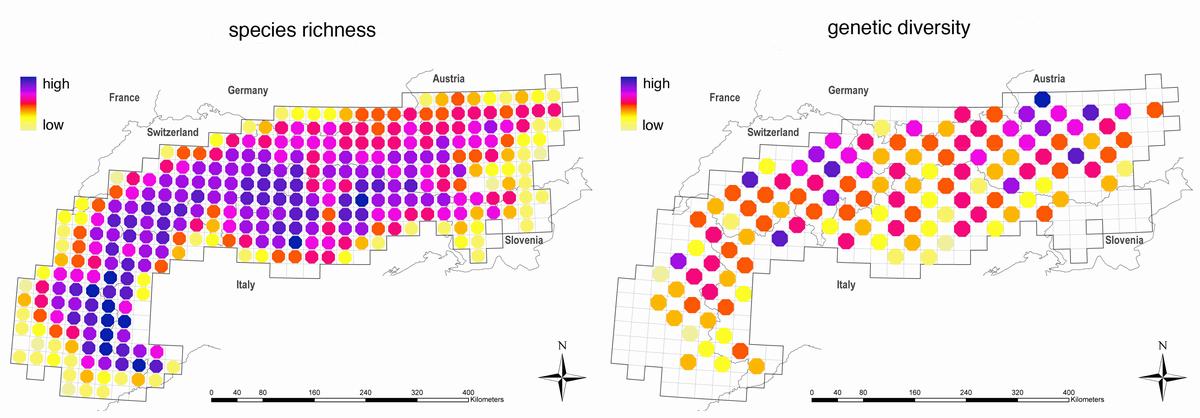An international team of researchers led by the University of Grenoble andthe Swiss Federal Institute for Forest, Snow and Landscape Research (WSL) hasdemonstrated for the first time that a high level of species diversity in alpineplants does not necessarily go hand in hand with a high level of geneticdiversity. This finding suggests that new future strategies are needed toprotect biodiversity in the Alpine region. The results of the study were publishedonline in Ecology Letters.
Biodiversity can be described at three levels: ecosystem diversity, speciesdiversity and genetic diversity. Previous theory assumed that the three levels arecongruent, amongst other reasons because they are subjected to the sameprocesses. According to this claim, regions with a high level of ecosystemdiversity should also be rich in species and those species should display ahigh level of genetic diversity. Genetic diversity is just as important as species diversity because itdetermines a species' adaptability to a changing environment. If climate changealters the prevailing environmental conditions in the Alps, the adaptability ofalpine plants will be key to the long-term preservation of species diversity.
An international team of researchers led by the University of Grenobleand the Swiss Federal Institute for Forest, Snow and Landscape Research (WSL) has now discovered that a high level of species diversity does not necessarily go hand in hand with a high level of genetic diversity. The researchers studied the distribution pattern of 893 alpine plants throughout the Alps. After taking the genetic fingerprints of 27 of these species, they found that species-rich areas are distinct from areas harboring high genetic diversity. Moreover, the researchers succeeded in pinpointing the reasons for this: in alpine plants, species diversity is influenced by local environmental conditions, whereas genetic diversity is determined by processes that led to the recolonization of ice-free areas after the last Ice Age. Furthermore, a parallel study conducted in the Carpathian mountains shows that this finding for the Alps was no 'one-off' result.
Comparison of species richness and genetic diversity in alpine plants in the Alps. Credit: Swiss Federal Institute for Forest, Snow and Landscape Research WSL
These findings are highly relevant for the conservation of biodiversityin the Alps. Today's designated conservation areas are locations where rarespecies occur and where ecosystem diversity and thus the number of species areparticularly high. However, this does not guarantee sufficient long-termprotection for alpine plants because their genetic diversity is onlyinsufficiently secured by current conservation areas. In future, then, existingconservation areas should be complemented by adding areas characterised by a highlevel of genetic diversity. In addition, new and existing conservation areasshould be more efficiently interlinked, as this would guarantee the exchange ofindividual plants and their genes between different populations of alpine plants and thus also maintain genetic diversity in the long term.
Reference: Taberlet P, Zimmermann NE, English T, Tribsch A, Holderegger R, AlvarezN, Niklfeld H, Coldea G, Mirek Z, Moilanen A, Ahlmer W, Ajmone-Marsan P, BonaE, Bovio M, Choler P, Cieślak E, Colli L, Cristea V, Dalmas J-P, Frajman B,Garraud L, Gaudeul M, Gielly L, Gutermann W, Jogan N, Kagalo AA, Korbecka G,Küpfer P, Lequette B, Letz DR, Manel S, Mansion G, Marhold K, Martini F,Negrini R, Niño F, Paun O, Pellecchia M, Perico G, Piękoś-Mirkowa H, Prosser F,Puşcaş M, Ronikier M, Scheuerer M, Schneeweiss GM, Schönswetter P,Schratt-Ehrendorfer L, Schüpfer F, Selvaggi A, Steinmann K, Thiel-Egenter C,Van Loo M, Winkler M, Wohlgemuth T, Wraber T, Gugerli F, IntraBioDiv Consortium(2012) Genetic diversity in widespread species is not congruent with speciesrichness in alpine plant communities. Ecology Letters online.
